We disassemble to the bottom ultrabook Lenovo IdeaPad U300s
A week ago, I decided to do preventive cleaning ultrabook Lenovo IdeaPad U300s. It would seem what the problem is - took a screwdriver and go. But upon closer inspection, it turned out that this model does not have visible screws. An empty spot was found under a rubber-peeled rubber boot. Given that no instructions for parsing the U300s on the Web could be found, I carefully glued the leg back and went to my repairman. The results of our meeting were so informative that the material was accumulated for the whole post.

Start over. To get inside the case, we need to gently pick up something with two sharp rubber legs, located next to the hinges of the top cover. In the photo they are marked with arrows. The legs are not glued, and then they can be easily returned to their place.
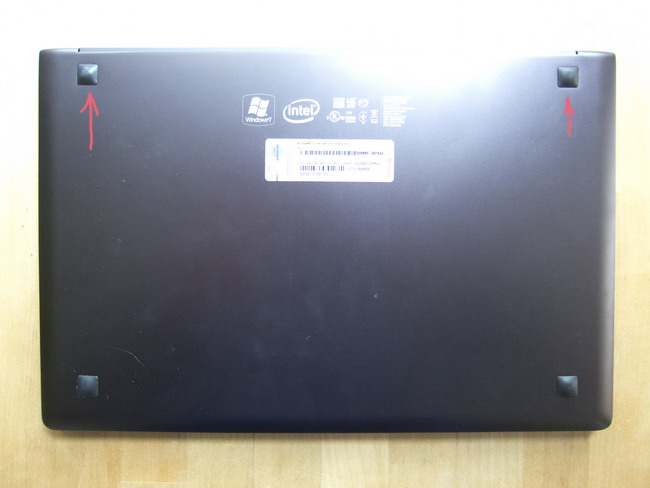
Inside we will see ... yes, in general, we will not see anything except the battery and the protective layer of the film.

The battery of the Lenovo IdeaPad U300s is not bad. You can count on five hours even with a serious load, and in Word + ICQ mode you can hold out for more than six. For an ultrabook on the previous generation Core i7 (Sandy Bridge), this is almost a record. In other matters, taking into account the dimensions and capacity of the battery, one should not be surprised.
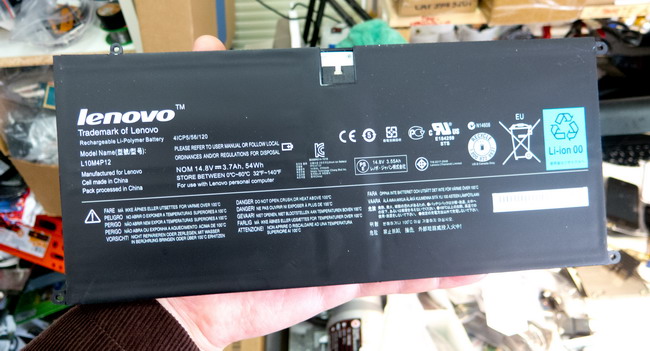
But this, you will not believe, SSD.

It looks like he was in a hurry soldered right at the factory. It was not possible to determine the breed - I just know that this is something based on the JMicron JMF616 controller. The interface, as you can easily see, is not standard mSATA, but more sophisticated. So you don’t have to dream about using in a computer or other ultrabook. Yes, and it will not be easy to upgrade.

In the next photo we see an ultrabook without a battery and SSD. Not without surprise we learn that the motherboard is made already in Japan itself. Also, one cannot fail to notice two coolers of the Taiwanese company Sunon. Honestly, I was sure that he was there alone.
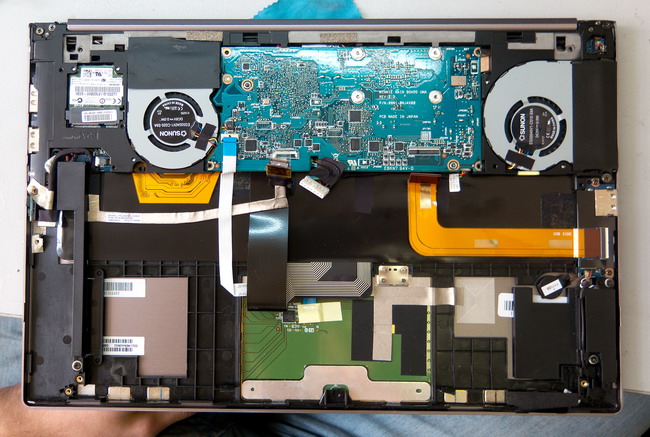
Further disassembly slowed down a bit. It turned out that the unit with the motherboard is firmly attached to the cover with the screen. And you need to disconnect the part where the battery and keyboard are. The interesting letter Z turned out.
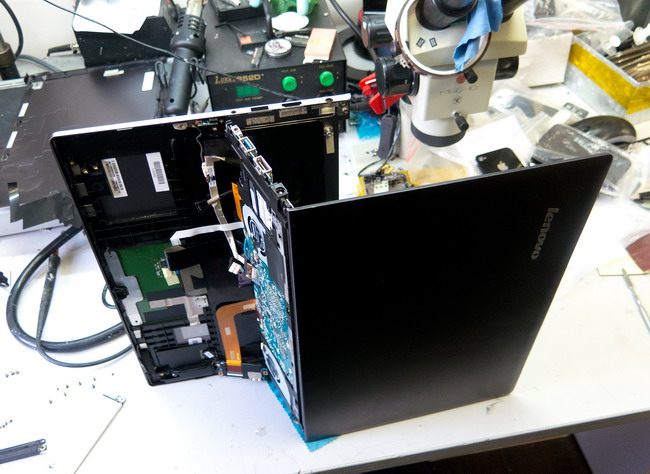
And here one more useful discovery awaited us. It turns out that in this model the memory is not soldered directly to the motherboard, but is inserted into a standard slot. And if the available 4 GB is not enough, you can double the volume. For many, this is important.
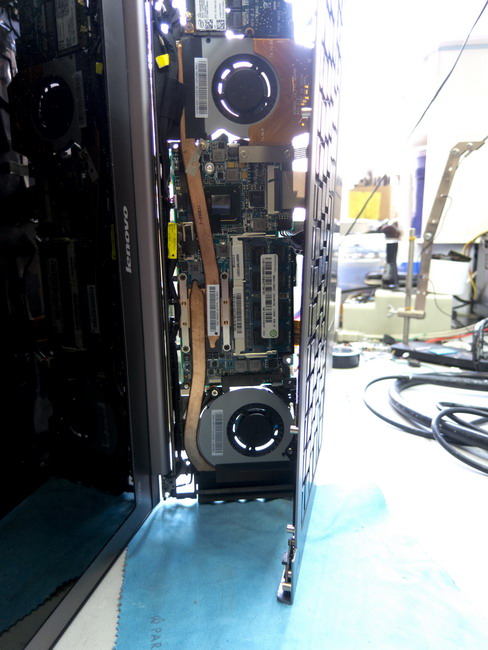
The WiFi adapter is pretty standard and Centrino is even written on it. I don’t see the reasons for changing it, but if you suddenly need to, this is not a problem.
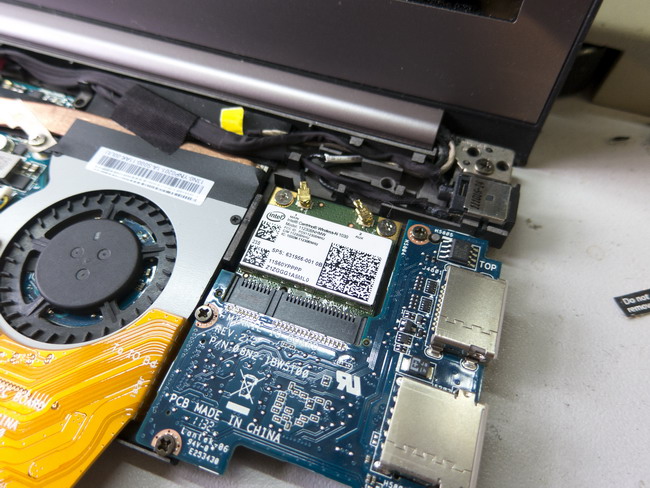
The chipset (aka the south bridge) is deprived of a radiator, apparently it is not required in such systems. Enough secondary cooling.
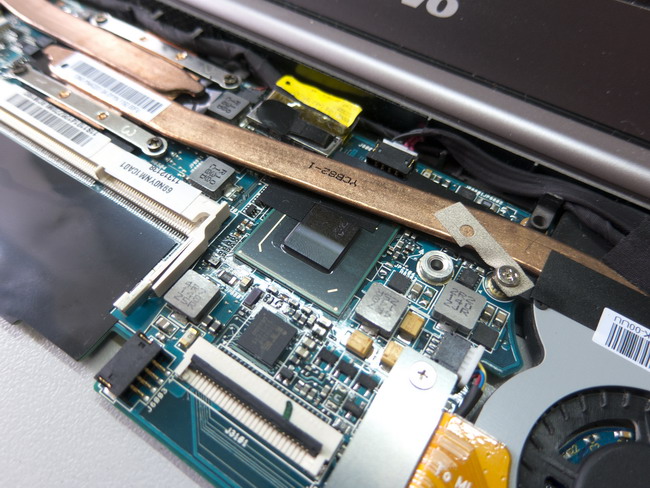
But two heat pipes lead to the processor.
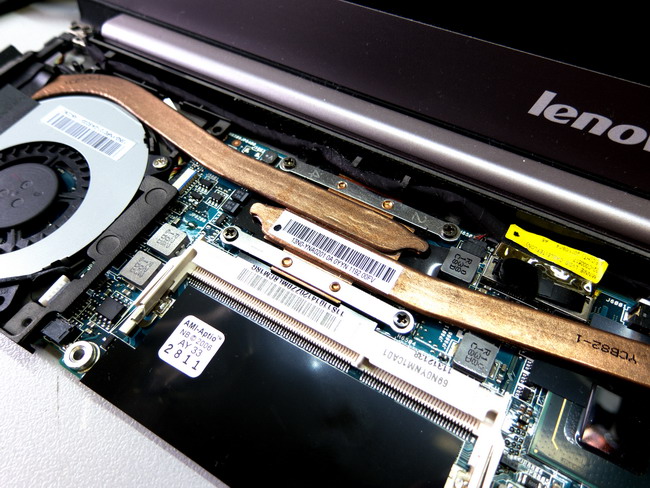
This model can not be called noisy, but coolers turn on often and you can hear them. It is worth noting that ultrabooks on Ivy Bridge, originally designed for this platform, easily cost one propeller.
Let's look at the same fragment from a different angle.
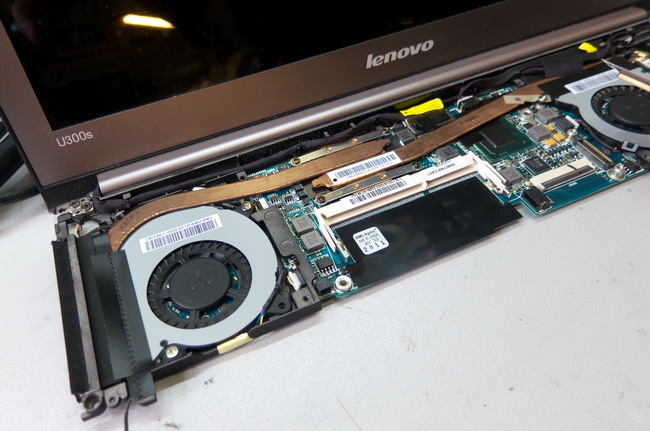
And these are connectors on one side. They are made on a separate scarf, which is no longer made in Japan, but in China. Such is internationalism within the framework of one system.
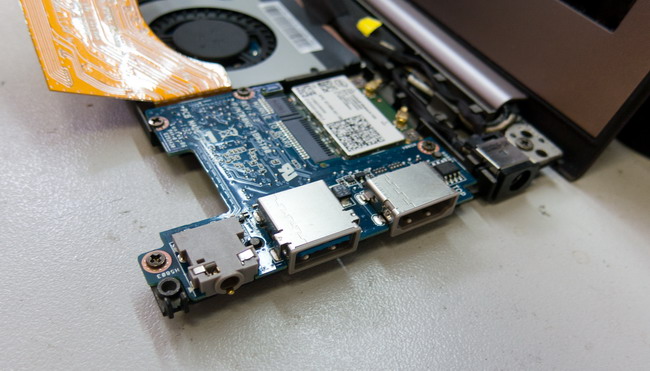
It is worth noting that during the parsing process, the master Alexander constantly said: “Well, well, they copied everything from the first generation MacBook Air!”. And with a careful look at the keyboard from the inside, he said at all that it was her, darling - from Air.
Well, judge for yourself. Here is the Lenovo keyboard.
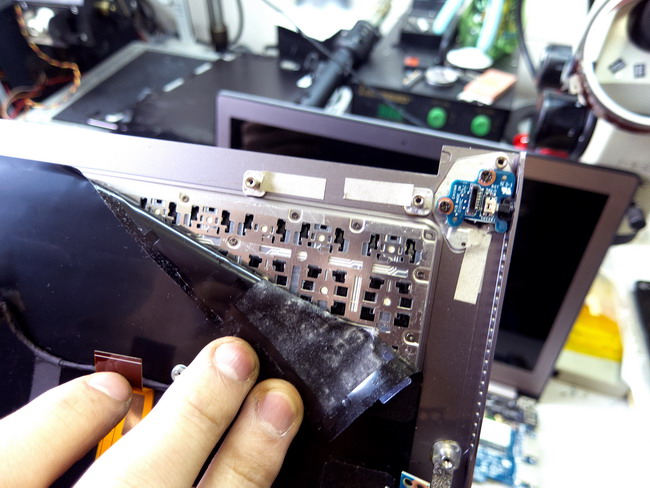
But from Air.

Indeed, a resemblance is present. I generally have a theory that ultrabook technology was developed on the MacBook Air, and then, by agreement between Intel and Apple, they were transferred to other companies. Nobody confirmed it to me, of course. But, on the other hand, only the blind can not notice the similarities between the first generation of ultrabooks and Airs. And the silence of Apple lawyers as a hint ... However, let's return to digging in hardware.
Having removed one of the radiators, Alexander noted the presence of a "ladder" on it (an arrow indicates it). According to him, there is nothing good in it, because dust always collects in this difference, reducing the efficiency of the cooling system and making it more noisy. Indeed, there was a lot of dust there, and only then I realized that in fact for the picture it was not necessary to clean it ...

And here is the last generation Core i7 with the removed cooling system. How small he is! Against this background, the laptop memory slot looks like a real giant.
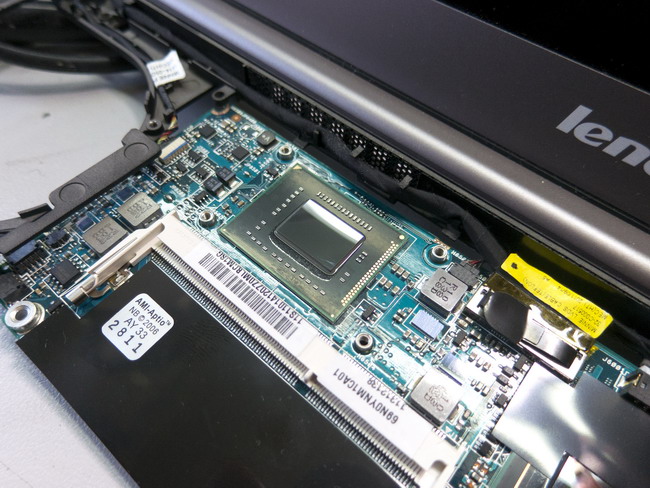
Well and one more small example of internationalism: the Taiwanese Sunon cooler is made in China. Twenty years ago, it would have been very difficult to imagine.
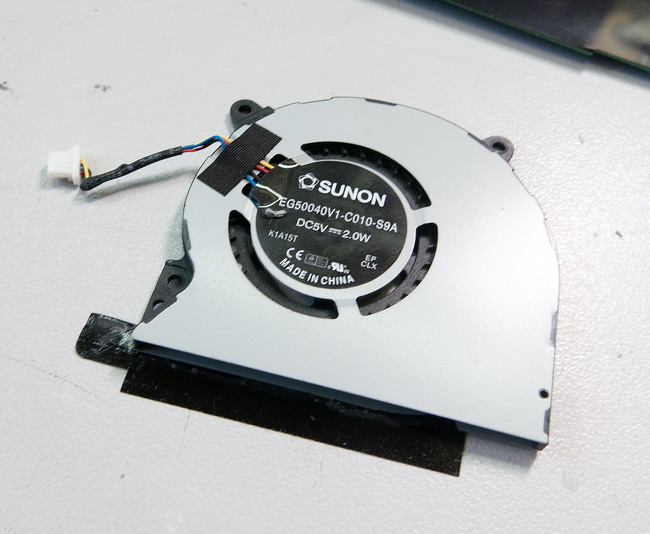
Another farewell look at the disassembled ultrabook ...
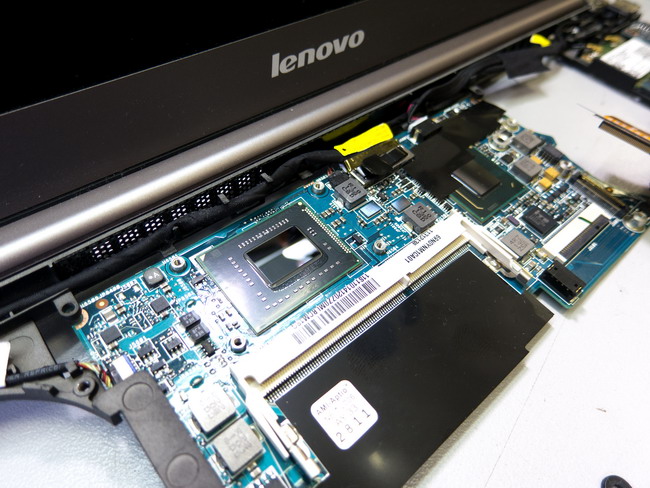
... and we begin the reverse process. To Sasha’s honor, everything was collected the first time and works no worse than before. To my credit - because I had to open it again somehow :)
At the same time as Lenovo IdeaPad U300s, we disassembled a new ultrabook on the Ivy Bridge Acer Aspire S5 with a very interesting driving platform with connectors. But I plan to write a separate post about him.
Many thanks to Alexander Levchenko ( Tech-Town.ru ) for their help in preparing the post.

Start over. To get inside the case, we need to gently pick up something with two sharp rubber legs, located next to the hinges of the top cover. In the photo they are marked with arrows. The legs are not glued, and then they can be easily returned to their place.

Inside we will see ... yes, in general, we will not see anything except the battery and the protective layer of the film.

The battery of the Lenovo IdeaPad U300s is not bad. You can count on five hours even with a serious load, and in Word + ICQ mode you can hold out for more than six. For an ultrabook on the previous generation Core i7 (Sandy Bridge), this is almost a record. In other matters, taking into account the dimensions and capacity of the battery, one should not be surprised.

But this, you will not believe, SSD.

It looks like he was in a hurry soldered right at the factory. It was not possible to determine the breed - I just know that this is something based on the JMicron JMF616 controller. The interface, as you can easily see, is not standard mSATA, but more sophisticated. So you don’t have to dream about using in a computer or other ultrabook. Yes, and it will not be easy to upgrade.

In the next photo we see an ultrabook without a battery and SSD. Not without surprise we learn that the motherboard is made already in Japan itself. Also, one cannot fail to notice two coolers of the Taiwanese company Sunon. Honestly, I was sure that he was there alone.

Further disassembly slowed down a bit. It turned out that the unit with the motherboard is firmly attached to the cover with the screen. And you need to disconnect the part where the battery and keyboard are. The interesting letter Z turned out.

And here one more useful discovery awaited us. It turns out that in this model the memory is not soldered directly to the motherboard, but is inserted into a standard slot. And if the available 4 GB is not enough, you can double the volume. For many, this is important.

The WiFi adapter is pretty standard and Centrino is even written on it. I don’t see the reasons for changing it, but if you suddenly need to, this is not a problem.

The chipset (aka the south bridge) is deprived of a radiator, apparently it is not required in such systems. Enough secondary cooling.

But two heat pipes lead to the processor.

This model can not be called noisy, but coolers turn on often and you can hear them. It is worth noting that ultrabooks on Ivy Bridge, originally designed for this platform, easily cost one propeller.
Let's look at the same fragment from a different angle.

And these are connectors on one side. They are made on a separate scarf, which is no longer made in Japan, but in China. Such is internationalism within the framework of one system.

It is worth noting that during the parsing process, the master Alexander constantly said: “Well, well, they copied everything from the first generation MacBook Air!”. And with a careful look at the keyboard from the inside, he said at all that it was her, darling - from Air.
Well, judge for yourself. Here is the Lenovo keyboard.

But from Air.

Indeed, a resemblance is present. I generally have a theory that ultrabook technology was developed on the MacBook Air, and then, by agreement between Intel and Apple, they were transferred to other companies. Nobody confirmed it to me, of course. But, on the other hand, only the blind can not notice the similarities between the first generation of ultrabooks and Airs. And the silence of Apple lawyers as a hint ... However, let's return to digging in hardware.
Having removed one of the radiators, Alexander noted the presence of a "ladder" on it (an arrow indicates it). According to him, there is nothing good in it, because dust always collects in this difference, reducing the efficiency of the cooling system and making it more noisy. Indeed, there was a lot of dust there, and only then I realized that in fact for the picture it was not necessary to clean it ...

And here is the last generation Core i7 with the removed cooling system. How small he is! Against this background, the laptop memory slot looks like a real giant.

Well and one more small example of internationalism: the Taiwanese Sunon cooler is made in China. Twenty years ago, it would have been very difficult to imagine.

Another farewell look at the disassembled ultrabook ...

... and we begin the reverse process. To Sasha’s honor, everything was collected the first time and works no worse than before. To my credit - because I had to open it again somehow :)
At the same time as Lenovo IdeaPad U300s, we disassembled a new ultrabook on the Ivy Bridge Acer Aspire S5 with a very interesting driving platform with connectors. But I plan to write a separate post about him.
